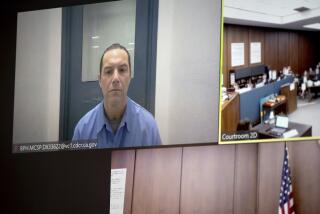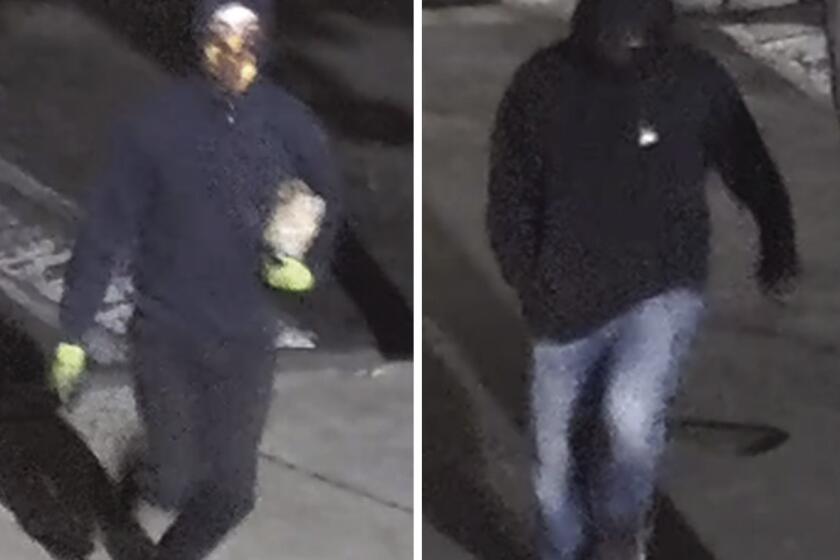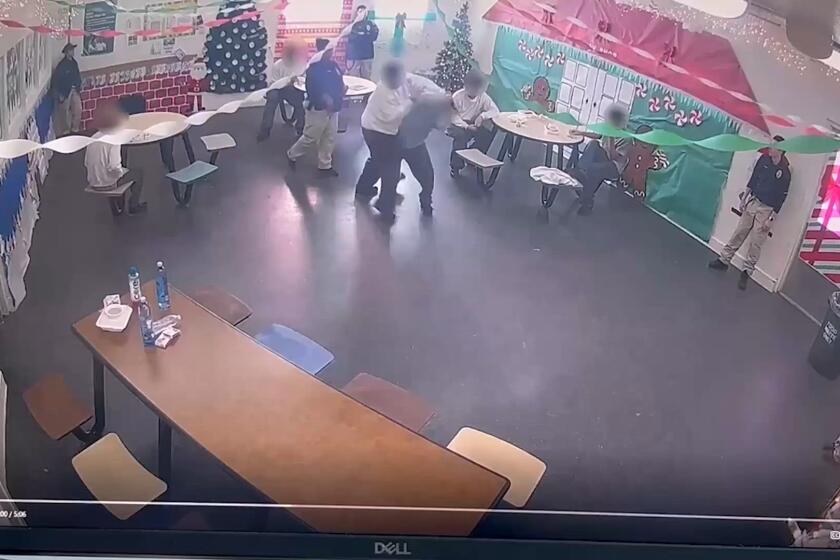Use Caution in Disposing of Toxic Waste
Household hazardous wastes include commonly used substances ranging from paints to pool-treatment chemicals. In 1985, they caused more than 143,000 injuries requiring emergency room care, according to National Injury Information Clearinghouse figures.
The typical Southern California home contains many dangerous toxic wastes lurking under kitchen sinks, in bathroom cabinets and on garage storage shelves. Most people don’t realize it’s illegal to dump these substances in the trash, down the drain or in the street.
In California, all residential garbage is taken to Class II sanitary landfills, which cannot legally accept bug spray, oven cleaners, paint products, antifreeze, kitchen and bathroom cleansers, drain openers, furniture polish or chlorine bleach.
Unfortunately many of these items are thrown into household trash barrels, picked up with the rest of the garbage and dumped into the local sanitary landfills. When put in the trash, these wastes can injure sanitation workers, leach into and pollute the water aquifer and disrupt sewage-treatment systems.
For many Southern California residents, particularly those in Los Angeles County, the only way to dispose of toxic trash is to hire a state-licensed hazardous-waste hauler, for about $300 or more, who will then deliver the goods to a Class I hazardous-materials landfill. Class I sites cannot accept pesticides.
There are only two such landfills serving Southern California: Kettleman Hills in Kings County and Casmalia in Santa Barbara County. Although at least three toxic-waste dump sites are being investigated in Los Angeles County in recent months, none has been approved.
Alternative Solutions
However, there are alternative solutions to expensive long-distance disposal of household hazardous waste. Some areas have programs to collect these wastes and deposit them in a Class I landfill. A few products can be recycled, but solving the dilemma often begins before the items are even purchased.
According to Sandi Shafer, coordinator of Orange County’s Household Hazardous Waste Project, consumers should know how to buy, handle and store these materials.
“Purchase only enough for what you need” to complete a project, Shafer says. By doing so, you eliminate part of the disposal problem. Check labels for these key words indicating a toxic substance: corrosive, flammable, poisonous, volatile, caustic or explosive.
Read and understand the directions before using. Don’t mix different products, because the result could be an explosive or poisonous chemical reaction. A common mistake is to combine chlorine and ammonia products, which creates a deadly gas. When working with such chemicals, wear gloves and protective goggles and keep the area well ventilated.
“Make sure you segregate incompatible products,” Shafer says. For instance, flammables should not be stored with corrosives. All containers should be kept in a sturdy storage area that’s inaccessible to children and pets.
As an alternative to using toxic substances, toxic specialists recommend substituting non-hazardous products to perform the same tasks. For example, baking soda or a combination of vinegar, salt and water can be used as all-purpose cleaners.
If you spill a hazardous substance or accidentally misuse it, call the 24-hour Toxic Information Center (800) 233-3360. If you get the product on your skin, in your eyes or swallow it, call the Poison Control Center (213) 484-5151 or (714) 634-5988. In an emergency, call 911.
Store toxic materials in stable, well-sealed containers, preferably their original ones, advises Jennifer Stone, toxic-chemical coordinator for the city of Santa Monica. If the original container breaks or leaks, place it in a larger compatible container with a seal.
Buy latex or water-based paints that do not require paint thinners. A small amount of water-based or latex paint can be dried on a paint can lid or on sheets of newspaper and then thrown in the trash, Shafer says. This does not apply to other paint products, which cannot be put in the garbage.
Other ways to dispose of leftover paint are to “paint the inside of the garage” or see if family, friends or charity can use it, suggests Bonnie Shear, a Los Angeles County Hazardous Waste Control representative. Some auto body shops may accept paint thinners.
Disposable diapers can also be a problem. If a diaper holds human waste, it should not be thrown into the trash. Yet the Environmental Protection Agency estimates about two million tons (wet weight) of these disposables wind up in U.S. landfills each year.
Before you throw out a diaper, you should flush the waste into the toilet, says Abraham Entin, chairman of the National Assn. of Diaper Services’ Committee on Health and the Environment.
Do it as you would with a cloth diaper, or tear out the inner lining with the waste and flush it down the toilet. The plastic covering goes in the garbage. As an alternative, use cloth diapers.
Used motor oil, brake and transmission fluids are accepted for recycling by some service stations. Call the California Waste Management Board’s Recycle Hot Line (800) 732-9225 for the nearest station.
Leftover pesticides and herbicides are picked up free of charge by county agricultural commission offices. A maximum of five gallons or 50 pounds is accepted and must be in a non-leaking, sealed container, preferably its original one.
For other household waste, some areas have designated collection waste sites or “toxic roundup days.” If you use these services, the amount you can transport or drop off is limited by state law to five gallons or 50 pounds.
Santa Monica and El Segundo have household hazardous-waste disposal programs. Both are annual one-day collections. Other cities have considered similar programs, so check with your municipal environmental health officer or the county health department.
Los Angeles County “does not have that type of service” for household toxics, according to Anastacio Medina, chief of the Hazardous Waste Control Program of the Los Angeles County Department of Health Services. “As the health department for 83 cities, we cannot get involved because of the tremendous liability risk.”
The City of Los Angeles also lacks a program for the disposal of household toxics. “We don’t have an active program at the present time,” said Robert Alpern, principal sanitation engineer for the city’s Bureau of Sanitation. However, funding has been approved for a project that would provide a pickup service for household toxics in a pilot area.
The City of El Segundo offers its residents a one-day collection site for household hazardous waste during its spring cleanup week, usually held in April. For more information, call (213) 322-4670.
Annual Roundup
In Santa Monica, the annual roundup is held the first weekend after Memorial Day for Santa Monica residents and small businesses. The drop-off site is in the Santa Monica City Hall parking lot, 1685 Main St., Santa Monica. During the roundup, pickup service for senior citizens may be provided. For more information, call (213) 458-8228.
Also, Santa Monica’s paint exchange program, (213) 458-8526, allows any quantities of usable but unwanted paint to be turned in and then made available to city residents at no charge. The purpose is to avoid people dumping paint they no longer want into sewers, landfills or down drains. (Paint that has solidified completely, though, can be thrown out with the trash, says Deborah Baine, recycling coordinator for the city.)
Orange County’s Hazardous Materials Program sponsored five roundup days since April, 1985, to educate residents on proper disposal procedures and to gather information on support for permanent sites. Permanent collection stations are expected to be established throughout the county by mid-May. For recorded information on permanent drop-off sites, call (714) 834-8892. San Bernardino County has two permanent household hazardous-waste collection sites run by its Department of Environmental Health Services for county residents only. The sites accept motor oil, weed killers, household cleaners, auto and furniture polish, chemical drain cleaners, pesticides and fertilizer, wood preservatives, paints and paint thinners. Waste should be in its original container, and the contents should be the same as what’s on the label.
The free service is available 8 a.m. to 5 p.m., Monday through Friday. Locations are the County Agricultural Commissioner’s office, 777 E. Rialto Ave., San Bernardino and the Central Valley Fire District, 15380 San Bernardino Ave., Fontana. San Bernardino County civic groups can have a neighborhood “roundup” of household hazardous waste by calling (714) 387-4629. San Diego County also provides its residents with a collection service. To make arrangements for disposal, you must first call the county Household Hazardous Materials Program, (619) 236-2267.
More to Read
More to Read
More to Read
Start your day right
Sign up for Essential California for news, features and recommendations from the L.A. Times and beyond in your inbox six days a week.
You may occasionally receive promotional content from the Los Angeles Times.






